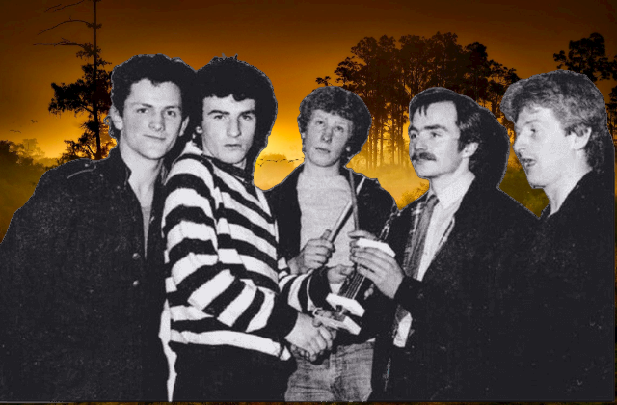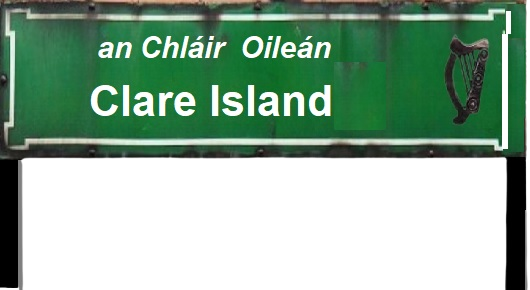Clare Island Lyrics And Chords By The Saw Doctors
This song is one of the band's biggest hits.
Return to the Saw Doctors Lyrics And Chords for more of these Galway boys hits .
Return to the Saw Doctors Lyrics And Chords for more of these Galway boys hits .
[D]Will you meet me on Clare [G]Island
Summer [D]stars are in the [A]sky
We’ll[D] get the ferry out from[G] Roonagh
And [D]wave all our [A]cares good[D]bye
And we’ll go dancing at the ceili
We’ll go kissing on the strand
Take our clothes off in the moonlight
Skinny-dipping hand in hand
And we’ll start drinking in the twilight
Keep it up until the dawn
In both the bars
Because there’s no guards
To take our names and send us home.
Will you meet me on Clare Island
Summer stars are in the sky
We'll get the ferry out from roonagh
And wave all our cares goodbye.
Gettin’ weary of the city
Seems so many things have changed
Let’s head off for Nora Dalys home
Where she’s walked
It never rained
So will you meet me on Clare Island
Summer stars are in the sky
We'll get the ferry out from roonagh
And wave all our cares goodbye
And if there’s wild and tall white horses
And the swell rolls in the bay
I won’t care if the boat can’t sail
Sure we’ll get home
Some other day
So will you meet me on Clare Island
Summer stars are in the skys
We'll get the ferry out from roonage
And wave all our cares goodbye
Summer [D]stars are in the [A]sky
We’ll[D] get the ferry out from[G] Roonagh
And [D]wave all our [A]cares good[D]bye
And we’ll go dancing at the ceili
We’ll go kissing on the strand
Take our clothes off in the moonlight
Skinny-dipping hand in hand
And we’ll start drinking in the twilight
Keep it up until the dawn
In both the bars
Because there’s no guards
To take our names and send us home.
Will you meet me on Clare Island
Summer stars are in the sky
We'll get the ferry out from roonagh
And wave all our cares goodbye.
Gettin’ weary of the city
Seems so many things have changed
Let’s head off for Nora Dalys home
Where she’s walked
It never rained
So will you meet me on Clare Island
Summer stars are in the sky
We'll get the ferry out from roonagh
And wave all our cares goodbye
And if there’s wild and tall white horses
And the swell rolls in the bay
I won’t care if the boat can’t sail
Sure we’ll get home
Some other day
So will you meet me on Clare Island
Summer stars are in the skys
We'll get the ferry out from roonage
And wave all our cares goodbye
Here's the chords in the key of G Major
[G]Will you meet me on Clare [C]Island
Summer [G]stars are in the [D]sky
We’ll[G] get the ferry out from[C] Roonagh
And [G]wave all our [D]cares good[G]bye
[G]Will you meet me on Clare [C]Island
Summer [G]stars are in the [D]sky
We’ll[G] get the ferry out from[C] Roonagh
And [G]wave all our [D]cares good[G]bye
and the Evolution of Genetics
Introduction
Clare Island, located off the west coast of Ireland, is a small and remote island with a rich history and unique ecology. It has been a site of scientific research since the mid-19th century, when the pioneering naturalist Robert Lloyd Praeger first visited the island. However, it was not until the late 20th century that Clare Island became a significant location for the study of genetics. The isolated nature of the island, combined with its diverse flora and fauna, has made it an ideal location for studying evolution and genetic variation. This thesis will explore the evolution of genetics on Clare Island, from the early studies of Praeger to the more recent research that has shed light on the island's unique genetic makeup.
Early Studies of Clare Island
Robert Lloyd Praeger, a renowned naturalist and founder of the Irish Naturalists' Field Club, first visited Clare Island in 1892. He was immediately struck by the island's diverse flora and fauna, and spent several years documenting and studying the island's biodiversity. Praeger's work was largely focused on taxonomy and classification, but he was also interested in the potential for genetic research on the island. He noted the isolation of the island and its potential as a natural laboratory for studying evolution and genetic variation.
Praeger's influence on the study of genetics on Clare Island was significant. His meticulous observations and collections of plants and animals laid the foundation for future research. However, it was not until the mid-20th century that genetics became a prominent field of study on the island.
The Emergence of Genetics on Clare Island
In the 1950s and 1960s, a team of researchers from Trinity College Dublin, led by Professor A.J. Cain, began to study the genetics of the island's flora. They were particularly interested in the genetic diversity of the island's rare and endemic species, such as the Clare Island heath (Erica lusitanica) and the Clare Island orchid (Dactylorhiza clareana). The team's work revealed that these species had a surprisingly high level of genetic diversity, despite the island's small size and isolation.
This research sparked a renewed interest in genetics on Clare Island, and subsequent studies by other researchers have further established the island as a valuable site for genetic research. In the 1970s and 1980s, studies by Dr. Peter Wyse Jackson and Dr. Charles Nelson revealed the presence of multiple genetic variants within some plant species on the island. This was significant as it challenged the long-held belief that isolated island populations would have low genetic diversity.
In the late 1980s, a new research project was initiated on Clare Island by Dr. John Breen and Dr. John O'Hara from University College Dublin. This project, known as the Clare Island Survey, aimed to study the genetic makeup of the island's human population. The researchers were particularly interested in studying the genetic structure of the island's inhabitants, who had been living on the island for generations and were largely isolated from the mainland. This study provided valuable insights into the genetic history and population structure of the island's residents.
Recent Research and Findings
In recent years, advances in genetic technology have allowed for more in-depth studies of the genetic makeup of Clare Island's flora and fauna. In 2013, a team of researchers from Trinity College Dublin and Queen's University Belfast carried out a study on the island's butterfly population. The researchers found that the butterflies on Clare Island were genetically distinct from those on the mainland, indicating that they had evolved in isolation on the island. This study highlighted the potential for genetic isolation and divergence on small islands like Clare Island.
Another recent study, published in 2018, focused on the genetic diversity of the island's bird population. This study, led by Dr. Nicola Marples from Trinity College Dublin, revealed that the island's birds were genetically distinct from those on the mainland, and also showed evidence of genetic adaptation to the island's unique environment. This research has important implications for understanding the processes of evolution and adaptation in isolated island populations.
Conclusion
Clare Island's remote location and diverse ecology have made it an ideal site for studying genetics and evolution. From the early studies of Robert Lloyd Praeger to the more recent research using advanced genetic technologies, scientists have been able to gain valuable insights into the genetic makeup and evolutionary history of the island's flora and fauna. The findings from these studies have not only contributed to our understanding of evolution and genetics, but have also highlighted the importance of protecting and conserving the unique biodiversity of this small but significant island.
Introduction
Clare Island, located off the west coast of Ireland, is a small and remote island with a rich history and unique ecology. It has been a site of scientific research since the mid-19th century, when the pioneering naturalist Robert Lloyd Praeger first visited the island. However, it was not until the late 20th century that Clare Island became a significant location for the study of genetics. The isolated nature of the island, combined with its diverse flora and fauna, has made it an ideal location for studying evolution and genetic variation. This thesis will explore the evolution of genetics on Clare Island, from the early studies of Praeger to the more recent research that has shed light on the island's unique genetic makeup.
Early Studies of Clare Island
Robert Lloyd Praeger, a renowned naturalist and founder of the Irish Naturalists' Field Club, first visited Clare Island in 1892. He was immediately struck by the island's diverse flora and fauna, and spent several years documenting and studying the island's biodiversity. Praeger's work was largely focused on taxonomy and classification, but he was also interested in the potential for genetic research on the island. He noted the isolation of the island and its potential as a natural laboratory for studying evolution and genetic variation.
Praeger's influence on the study of genetics on Clare Island was significant. His meticulous observations and collections of plants and animals laid the foundation for future research. However, it was not until the mid-20th century that genetics became a prominent field of study on the island.
The Emergence of Genetics on Clare Island
In the 1950s and 1960s, a team of researchers from Trinity College Dublin, led by Professor A.J. Cain, began to study the genetics of the island's flora. They were particularly interested in the genetic diversity of the island's rare and endemic species, such as the Clare Island heath (Erica lusitanica) and the Clare Island orchid (Dactylorhiza clareana). The team's work revealed that these species had a surprisingly high level of genetic diversity, despite the island's small size and isolation.
This research sparked a renewed interest in genetics on Clare Island, and subsequent studies by other researchers have further established the island as a valuable site for genetic research. In the 1970s and 1980s, studies by Dr. Peter Wyse Jackson and Dr. Charles Nelson revealed the presence of multiple genetic variants within some plant species on the island. This was significant as it challenged the long-held belief that isolated island populations would have low genetic diversity.
In the late 1980s, a new research project was initiated on Clare Island by Dr. John Breen and Dr. John O'Hara from University College Dublin. This project, known as the Clare Island Survey, aimed to study the genetic makeup of the island's human population. The researchers were particularly interested in studying the genetic structure of the island's inhabitants, who had been living on the island for generations and were largely isolated from the mainland. This study provided valuable insights into the genetic history and population structure of the island's residents.
Recent Research and Findings
In recent years, advances in genetic technology have allowed for more in-depth studies of the genetic makeup of Clare Island's flora and fauna. In 2013, a team of researchers from Trinity College Dublin and Queen's University Belfast carried out a study on the island's butterfly population. The researchers found that the butterflies on Clare Island were genetically distinct from those on the mainland, indicating that they had evolved in isolation on the island. This study highlighted the potential for genetic isolation and divergence on small islands like Clare Island.
Another recent study, published in 2018, focused on the genetic diversity of the island's bird population. This study, led by Dr. Nicola Marples from Trinity College Dublin, revealed that the island's birds were genetically distinct from those on the mainland, and also showed evidence of genetic adaptation to the island's unique environment. This research has important implications for understanding the processes of evolution and adaptation in isolated island populations.
Conclusion
Clare Island's remote location and diverse ecology have made it an ideal site for studying genetics and evolution. From the early studies of Robert Lloyd Praeger to the more recent research using advanced genetic technologies, scientists have been able to gain valuable insights into the genetic makeup and evolutionary history of the island's flora and fauna. The findings from these studies have not only contributed to our understanding of evolution and genetics, but have also highlighted the importance of protecting and conserving the unique biodiversity of this small but significant island.




